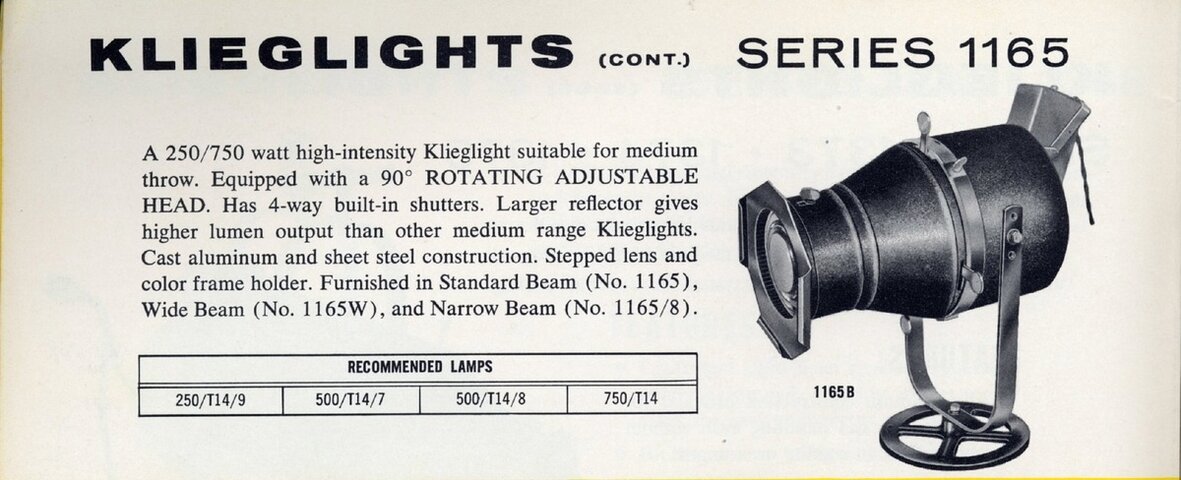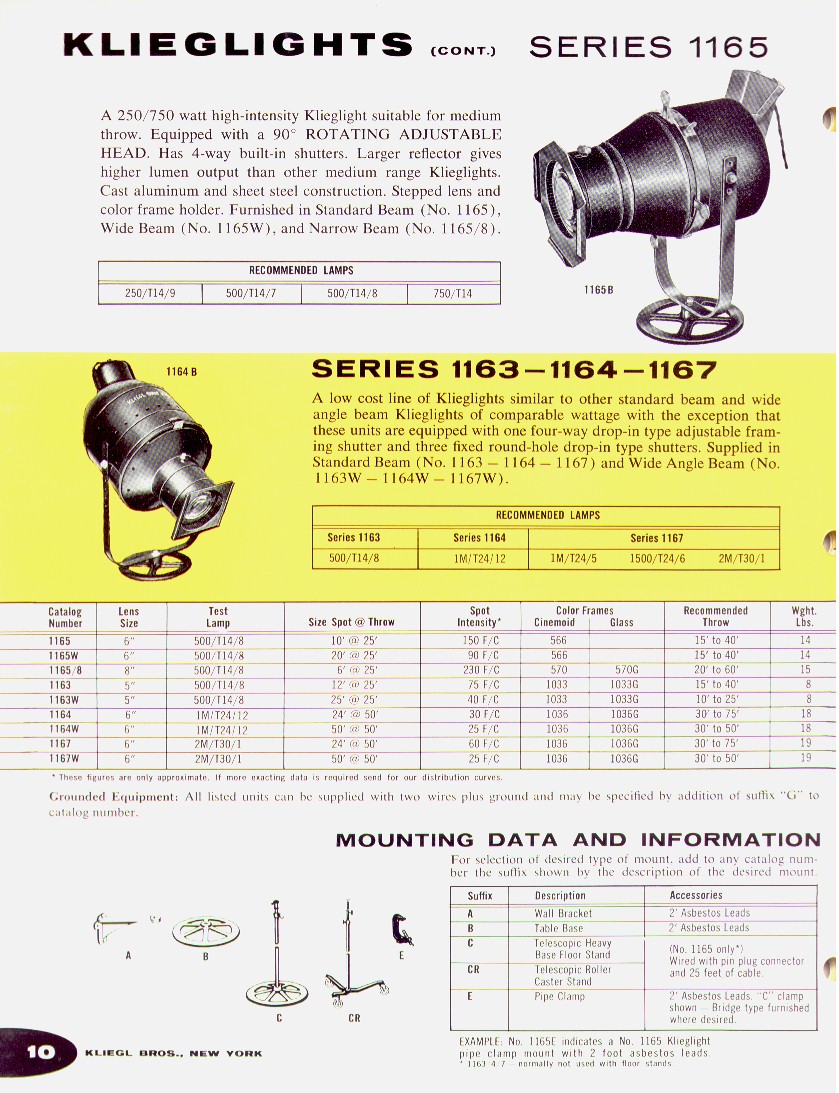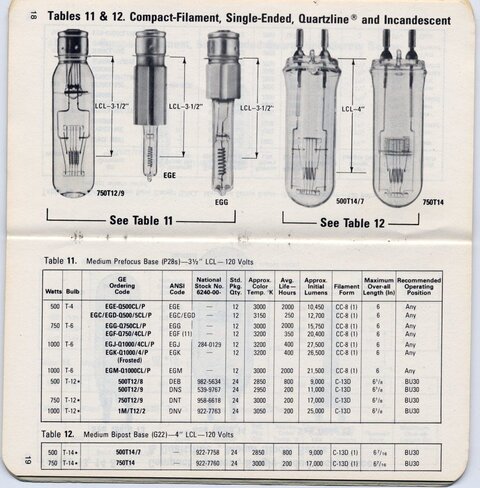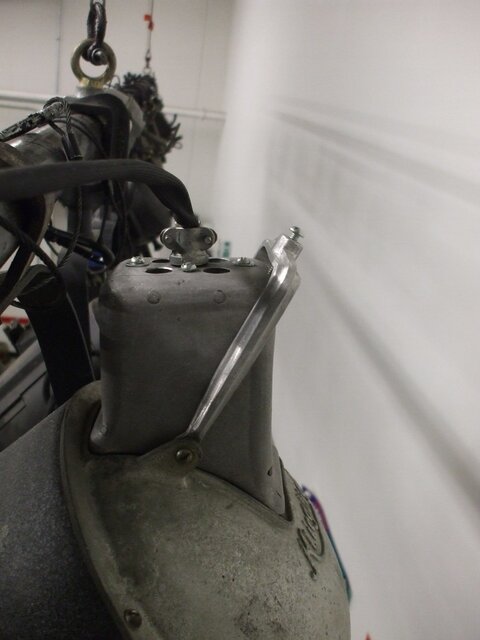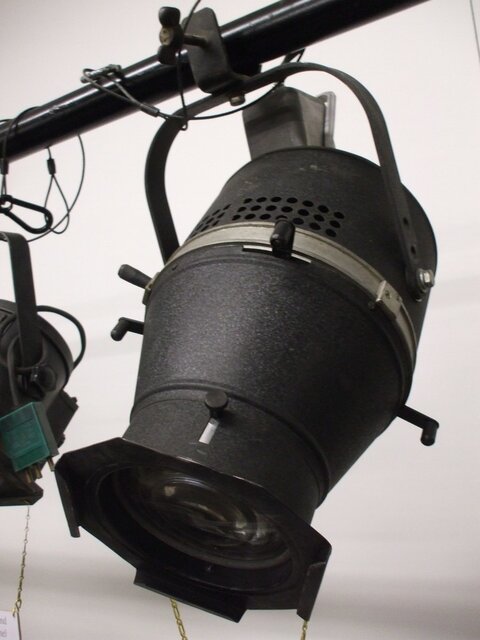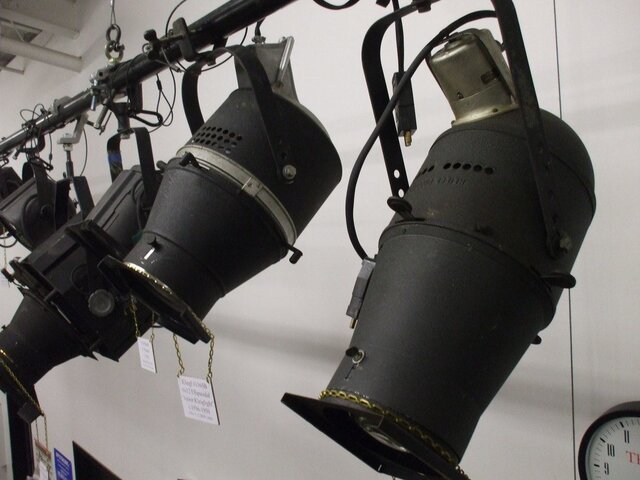So I bid on by mistake, and won for $9.99 a Kliegl Leko.
Mistake in the Kliegl, because it was missing both lens train and lamp cap. Vara-Light/Dimatronics/Hub Electric might have the parts, (Might... or perhaps in having seen them before, as with some other parts I can fabricate it if anyone has an example I can compare from other than with memory.) This worry, also because it had a spoked floor base in the photo and while I couldn’t tell scale in the E-Bay photo, I have two similar shaped ones with spoked bases from Major under Century #1560 8x10 cannons and I feared I had to make room for another 50# cannon of a fixture.
http://www.klieglbros.com/catalogs/40c36/cat40p45.jpg
I was ever so happy when I picked it up and it was about the size of a fat baby instead. The normal 18" spoked floor base was designed for use with stage screws to hold it down. This as opposed to a normal 40# weighed base of today, these screwed the base down to the deck as per normal scenery. This spoked base for a 6" Leko I got was called a “Table Top Mount” and is slightly countersunk for a say #10 flat head screw. Never seen a 6" Junior Klieglight type fixture of this type before, or a 9" spoked base before - normally they are weighted bases for that size that I have seen. Should fit in well between that above Century display and happy now to have it.
Very interesting ETC Leko like swivel lens train so the shutters focus properly on what you need them to. First time I have seen that before - the Century’s of similar style I have didn’t have that innovation, nor did later gear from Kliegl 1164 Leko’s that survived years later. After some research on the Kliegl Brother’s website, it’s definately a #1165B model, only seemingly is not the one presented either in the 1936 catalogue (link to,) or the 1950 catalogue. Has elements of both.
The 1936 catalogue has the aluminum slip plate casting that allows the shutters/lens train to rotate 360°, has the center part of this ring black in color, mine isn’t painted more like the 1950 version. Neither shows the 1/4-20 threaded tapped hole in one of the rotating mounts so as to rotate the lens train by way of some form of handle or knob. That’s a problem in re-producing that missing part. Was it some form of lever, or just a knob?
The shutter knobs are as similar to what’s in the 1936 photo and not the more like Altman 360 style shutter handles as in the 1950's catalogue. All slotted screws in use so far appairent on the fixture so far, though the first I have seen the use of some truss head type slotted screws also in use for attaching the lens train snout.
Lampholder retainer bracket as per this era of Leko is broken at about 1/3, but it’s using pound rivets. Yoke mount is using bolts instead of handles as per the norm I have seen before on the Century above Leko’s. (Proper Lekos - they even say Lekolight.)
Brass tacks on this very cute but chubby Leko in research. It’s missing it’s most important parts in dating it, and is clearly somewhere in between the two catalogues. That’s a problem in that while both have a step lens in use, between the catalogues, the lens train gel frame clip differs. Easy enough to cut a Altman lens train down to match either style - just gotta know which. Also, think I have a 6" step lens in stock, otherwise the above dealer possibly might.
Real question is in the missing lamp cap. Same lamp cap and possibly I can get or make one (though if anyone has one for the 6" or 8" version extra... $$$), more a question of Kliegl at some point upgrading to a completely different lamp during this time period.
Initially Kliegl was using a Fresnel like P-28s 500T-12 type of lamp similar to what Radial Lekos use but a bit different LCL for that lamp. In the 1950 catalogue on the other hand, they list a 500T-14 medium bi-post lamp on the other hand. That’s a G-22 base for it and really odd for any Leko to be using (never heard of other than a higher wattage studio type using that style of lamp domestically). 500T14/7 G.E. #21803 at 800 lamp rated hours, LCL of 4" this verses the 1936 catalogue listing a 500wT-12 Medium Pre-Focus P-28s lamp for it. I don’t track that discontinued 200hr lamp, but find it interesting this change to bi-pin as opposed to the rest of the industry doing medium pre-focus for the Leko's until the 60's with other say ANSI type DEB type T-12 lamps later that had the same lamp hours but kept the same medium pre-focus base. The LCL of 3.1/2" of the DEB overall isn’t much given seat heights of differing bases for mounting.
As important in Leko history - Radial Leko history... the 4" LCL T-12 medium pre-focus lamp had a lamp life of 200 hours for the spot version. The B-pin version had a lamp life of 800 hours. Following this, the normal radial Leko now somehow seemigly went back to medium prefocus 3.1/2" lamp LCL in use. Important given the above lamp change and return back in bulb type detals. Very important for Leko history as to what came when or changes between as "current science" and dating of fixtures. Won't help this fixture but questions raised as to which it is.
Thus also my conundrum about is this a 1936 or 1950 fixture in given I get the parts to it, which one it really is? No serial numbers I can find and possibly it could be either version in being a “in-between” catalogue model.
Last part, anyone have an extra rectangular cap Kliegl Leko lampholder cap? That’s gonna be the most difficult part to get. The rest I can punt with. I don’t have an example of it to copy the cap from either in making fabricating it easier either. Know how it works and about to get a pre-360 series Altman Leko that uses the same yoke mounted cap concept as based off the 1164 Kliegl system.. But round cap and this is rectangular.
Anyone have help here with spare parts, or parts to copy? More refining info on which type of lamp this will have used?
Mistake in the Kliegl, because it was missing both lens train and lamp cap. Vara-Light/Dimatronics/Hub Electric might have the parts, (Might... or perhaps in having seen them before, as with some other parts I can fabricate it if anyone has an example I can compare from other than with memory.) This worry, also because it had a spoked floor base in the photo and while I couldn’t tell scale in the E-Bay photo, I have two similar shaped ones with spoked bases from Major under Century #1560 8x10 cannons and I feared I had to make room for another 50# cannon of a fixture.
http://www.klieglbros.com/catalogs/40c36/cat40p45.jpg
I was ever so happy when I picked it up and it was about the size of a fat baby instead. The normal 18" spoked floor base was designed for use with stage screws to hold it down. This as opposed to a normal 40# weighed base of today, these screwed the base down to the deck as per normal scenery. This spoked base for a 6" Leko I got was called a “Table Top Mount” and is slightly countersunk for a say #10 flat head screw. Never seen a 6" Junior Klieglight type fixture of this type before, or a 9" spoked base before - normally they are weighted bases for that size that I have seen. Should fit in well between that above Century display and happy now to have it.
Very interesting ETC Leko like swivel lens train so the shutters focus properly on what you need them to. First time I have seen that before - the Century’s of similar style I have didn’t have that innovation, nor did later gear from Kliegl 1164 Leko’s that survived years later. After some research on the Kliegl Brother’s website, it’s definately a #1165B model, only seemingly is not the one presented either in the 1936 catalogue (link to,) or the 1950 catalogue. Has elements of both.
The 1936 catalogue has the aluminum slip plate casting that allows the shutters/lens train to rotate 360°, has the center part of this ring black in color, mine isn’t painted more like the 1950 version. Neither shows the 1/4-20 threaded tapped hole in one of the rotating mounts so as to rotate the lens train by way of some form of handle or knob. That’s a problem in re-producing that missing part. Was it some form of lever, or just a knob?
The shutter knobs are as similar to what’s in the 1936 photo and not the more like Altman 360 style shutter handles as in the 1950's catalogue. All slotted screws in use so far appairent on the fixture so far, though the first I have seen the use of some truss head type slotted screws also in use for attaching the lens train snout.
Lampholder retainer bracket as per this era of Leko is broken at about 1/3, but it’s using pound rivets. Yoke mount is using bolts instead of handles as per the norm I have seen before on the Century above Leko’s. (Proper Lekos - they even say Lekolight.)
Brass tacks on this very cute but chubby Leko in research. It’s missing it’s most important parts in dating it, and is clearly somewhere in between the two catalogues. That’s a problem in that while both have a step lens in use, between the catalogues, the lens train gel frame clip differs. Easy enough to cut a Altman lens train down to match either style - just gotta know which. Also, think I have a 6" step lens in stock, otherwise the above dealer possibly might.
Real question is in the missing lamp cap. Same lamp cap and possibly I can get or make one (though if anyone has one for the 6" or 8" version extra... $$$), more a question of Kliegl at some point upgrading to a completely different lamp during this time period.
Initially Kliegl was using a Fresnel like P-28s 500T-12 type of lamp similar to what Radial Lekos use but a bit different LCL for that lamp. In the 1950 catalogue on the other hand, they list a 500T-14 medium bi-post lamp on the other hand. That’s a G-22 base for it and really odd for any Leko to be using (never heard of other than a higher wattage studio type using that style of lamp domestically). 500T14/7 G.E. #21803 at 800 lamp rated hours, LCL of 4" this verses the 1936 catalogue listing a 500wT-12 Medium Pre-Focus P-28s lamp for it. I don’t track that discontinued 200hr lamp, but find it interesting this change to bi-pin as opposed to the rest of the industry doing medium pre-focus for the Leko's until the 60's with other say ANSI type DEB type T-12 lamps later that had the same lamp hours but kept the same medium pre-focus base. The LCL of 3.1/2" of the DEB overall isn’t much given seat heights of differing bases for mounting.
As important in Leko history - Radial Leko history... the 4" LCL T-12 medium pre-focus lamp had a lamp life of 200 hours for the spot version. The B-pin version had a lamp life of 800 hours. Following this, the normal radial Leko now somehow seemigly went back to medium prefocus 3.1/2" lamp LCL in use. Important given the above lamp change and return back in bulb type detals. Very important for Leko history as to what came when or changes between as "current science" and dating of fixtures. Won't help this fixture but questions raised as to which it is.
Thus also my conundrum about is this a 1936 or 1950 fixture in given I get the parts to it, which one it really is? No serial numbers I can find and possibly it could be either version in being a “in-between” catalogue model.
Last part, anyone have an extra rectangular cap Kliegl Leko lampholder cap? That’s gonna be the most difficult part to get. The rest I can punt with. I don’t have an example of it to copy the cap from either in making fabricating it easier either. Know how it works and about to get a pre-360 series Altman Leko that uses the same yoke mounted cap concept as based off the 1164 Kliegl system.. But round cap and this is rectangular.
Anyone have help here with spare parts, or parts to copy? More refining info on which type of lamp this will have used?
Last edited:



